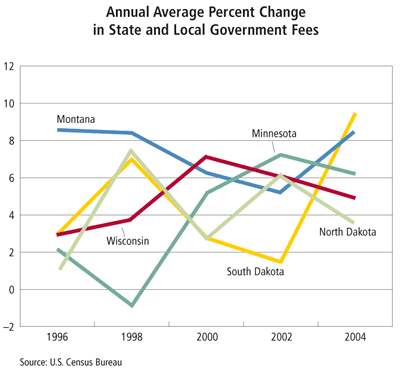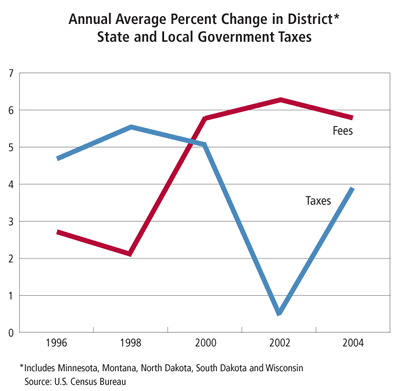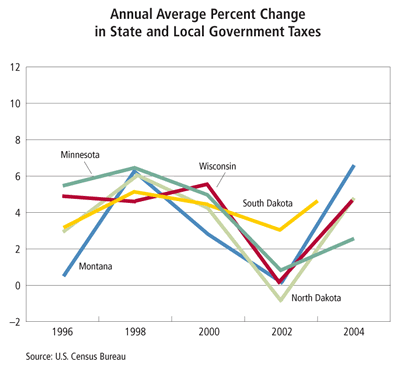If you've been paying attention to your water bill, you may have noticed an increase in rates in recent years. You might have been nicked again with a higher registration fee for your car, boat or all-terrain vehicle—and possibly all three. Come to think of it, your fishing license was more this year, and the cost of getting your passport for that trip to Cancun seemed pretty steep too.
The theme of these rising expenses is that they are all government fees. While fees don't have the scale or the visibility of taxes, their presence and overall cost have been on a steady incline. And if you're a user of these services, you can no more avoid these price hikes than you could the tax man.
In Minnesota, for example, water and sewer rates are forecast to continue rising because water systems are in need of major improvements. Over the next two decades, and assuming that improvements are paid for by ratepayers, annual household costs for water and sewer services will grow from $401 to $727, according to a report last year by the League of Minnesota Cities. That's absent any run-of-the-mill increases from operations, inflation or other unpredictable matters.
And this is just one of a litany of government fee increases across the Ninth District, either recently undertaken or likely in the future, both big and small, and all of them coming to your pocketbook. In Wisconsin, legislators are considering hikes in a number of fees to help close a $1.6 billion budget deficit, including a $10 bump in the annual motor vehicle registration fee. In South Dakota, livestock ownership inspection fees increased by a dime per animal and now total 80 cents per head. At the University of North Dakota, mandatory annual student fees topped $1,000 for the 2006-07 school year, according to a November report by an accrediting agency.

In Minnesota, a spreadsheet of changes made to government fees, co-pays and surcharges during the 2003 and 2005 legislative sessions runs 10 pages long. For the 2006-07 biennium, these changes are expected to add about $934 million in revenue to the state, according to a March 2006 report by the Minnesota Office of Senate Counsel, Research and Fiscal Analysis.
U.S. Census data show that government fee revenue has been rising rapidly at the state and local levels among all Ninth District states. Though fees provide a relatively small portion of total government revenue, their growth has been accelerating and has outpaced growth in tax revenue during the first part of this decade at both the state and local levels (see chart).

Is the rise in fees good, bad or indifferent? Cumulatively, it's hard to say, because it depends on the types of public goods and services involved, and detailed data on such matters are generally not available. For classic kinds of public goods (think national defense) whose benefits are widely dispersed, nonrival (one person's consumption of the good does not keep it from others) and nonexcludable (no way to prevent its consumption once available), economists argue that all people should bear the cost through general taxation. A tax paid by everyone removes the free-rider problem—people who benefit but are not paying.
But not all public goods or services fit this definition. Fees come into play, at least theoretically, as the users and beneficiaries of public goods become more narrow and well defined (in econ-speak, more rival and excludable). For example, public education is funded through taxes. But as budgets get tight, fees are being widely introduced to help fund such things as extracurricular activities, with participants bearing the cost.
That general phenomenon appears to be a common reason for the rise in government fees: Pressure has been mounting to hold the line on taxes, and governments at all levels are asking the users of certain services to bear more of the cost in order to maintain the service—a move economists applaud because it's a more efficient way of providing service when beneficiaries are limited.

But there is not always a direct link between the fee being charged and the cost to provide the service, and there appears to be some evidence of a revenue shell game going on as governments seek new sources of revenue given the backlash against higher taxes. In some cases, new charges are fees in name only; fundamentally, they are taxes because they are not charged based on service use.
Fees also appear to be going up because they can, politically speaking. Many are small in actual cost, and the process for increasing them comparatively simple. Fees have little uniformity among the many hundreds of government units authorized to charge them, and there is no central entity keeping tabs on the cumulative number of fees and their growth in cost over time.
While taxpayers can easily see the prevailing trend in property and income taxes they pay every year, getting a handle on fee increases is something like being in a drafty room: You notice it, but sometimes you're not sure where it's coming from, and it's not breezy enough for you to hunt out the source and do something about it. Some believe this dispersed, nickel-and-dime strategy distracts the public from closer scrutiny of government fees and defuses any buildup of public outrage.
The rising tide of fees
Fees exist at all levels of government, from the state down to villages and townships. Fees are charged for products or services not otherwise financed through general government revenue. The fees included in this analysis include user charges (refuse collection), fines and penalties (speeding ticket), licenses and permits (marriage, building) and utilities. Special assessments are not included.
Fees are an integral component of government revenues, comprising between 12 percent and 18 percent of combined government revenues (state and local) in the district. In Minnesota, fees make up 16 percent of government revenue. That sounds like a fairly small fraction, but it added up to $7 billion in 2004, according to Census data.
Fees charged by state governments have been rising for the past 10 years and, in some cases, much faster than tax revenues. Wisconsin and Montana saw particularly steep increases relative to the other district states and also in relation to tax revenue increases. (See charts nearby for rate of change in government fees and taxes in district states from 1996 to 2004. See annual data [xls] on government fee and tax collections in district states from 1995 to 2004, referenced throughout this article.)
Fees charged by state governments also accelerated over time in three of five district states and were typically much higher than growth in taxes. For example, between 1995 and 1999, Minnesota was losing fee revenue at the state level, but five years later fee revenues had increased nearly 43 percent (from 2000 to 2004); by comparison, taxes in Minnesota grew by just 10 percent during the latter period. South Dakota was the only real outlier in the district; state government fee revenue actually declined between 2000 and 2004.
But South Dakota offers a good segue to the general fee trends in local government. At the local level, fee revenue growth between 1995 and 2004 was higher than tax revenue growth for every district state. Fee revenue also accelerated over time: Three of five district states saw local government fees grow faster in the second half of this period than in the first half. Local governments in South Dakota saw their cumulative fee revenues grow by 40 percent—tops in the district—though local governments in every district state saw fees increase by at least 17 percent from 2000 to 2004.
Taxes are still rising, to be sure. But their increases have generally been slower of late, both compared to fees and compared to their rate of growth in the latter half of the 1990s. That's particularly the case at the state-government level. There is no consistent pattern for local-level taxes in the district,save for the fact that they've risen faster than state-level taxes.
Neither is the district an outlier in regard to rising fees. Substantial growth in fee revenue has occurred throughout the nation. According to the National Conference of State Legislatures Foundation of Fiscal Partners, governments at both the state and local levels in 1999 were relying more heavily on user charges as a source of government revenue and were decreasing reliance on taxes, especially property taxes. And the trend shows no signs of abating. For example, fees in Minnesota are expected to increase by $1.6 billion from 2004 to 2007, according to the nonpartisan Minnesota Senate Research.
The million-dollar question
Why are government fees increasing? The Foundation of Fiscal Partners suggests three reasons. First, in 1978, California's Proposition 13 triggered a wave of legislation limiting property taxes throughout the United States. Governments were forced to find other revenue sources after property tax revolts in the 1970s and 1980s.
During that time, property taxes equated to roughly 3.5 percent of national income. Today that number is around 3.1 percent. The small percentage gap equals hundreds of billions of dollars for governments. And when one revenue source is diminished, another one has to kick in if overall government spending is to increase (as it has). Not all of the revenue gap has been replaced by fees, but pressure on property taxes was motivation enough for governments to look for alternative funding sources.
State governments saw similar pressure to hold the line on taxes when the national economy fell into recession early this decade and pulled state budgets into the red. To make up that gap, states again had to get creative in filling budget holes. Along with raising fees for things like motor vehicle registration, state lawmakers typically pushed much of the burden onto local governments by cutting government aid. Local governments, in turn, raised fees (among other things) to balance their budgets.
Second, voters and policymakers are more comfortable with fees than with taxes, in part because they are user-based. If a person disagrees with a fee, or the necessity of an increase, in most cases he or she can avoid it by not using the service. Many politicians, including Minnesota Gov. Tim Pawlenty, have gone to the mat promising no new taxes, but have willingly passed new or higher fees based on this premise.
Third, higher fees are believed to be the result of their piecemeal nature. Most fees today are generally established through a public process on a fee-by-fee basis, though there are exceptions depending on the type of fee and the level of government where the fee is enacted. By and large, though, departments and agencies at every level of government recommend new fees or changes to existing fees. A public hearing is advertised and then held regarding the proposal, after which an elected body decides whether or not to enact the fee.
In many cases, fees go up because they can; often the increase and total charge of the fee is relatively small, and there is not a lot of scrutiny or other public "sunshine" on the matter. Mike Murray, a county commissioner in Lewis & Clark County, Mont., claims that 90 percent of fees pass when they go through the public process. Fees tend to have a targeted audience; thus, the constituency protesting a specific fee increase is smaller than one for broader tax increases, which affect everyone.
The flexible constitution of fees also allows state and local governments to sometimes fund activities unrelated to the fee itself—in essence, turning a fee into more of a hidden tax. For example, the $100 marriage license fee in Minnesota has many purposes. By state law, $15 is retained by the county giving the license and $85 goes to the state commissioner of finance. The $85 is then dispersed as follows: $50 to the general fund and the rest to the commissioners of health, education, human services, and employment and economic development to fund programs related to the family. To reduce the license fee to $30, a couple may opt to attend 12 hours of premarital education. In this case, the county retains $15 and the commissioner of finance receives $15 as well, $10 of which is deposited into a special revenue fund directed to employment and economic development.
How often this revenue-padding occurs is anybody's guess, given its widespread and flexible nature. But it's starting to get some attention. Matt Heimdahl from the Taxpayers League of Minnesota thinks there is something amiss in how fees are being created and spent. Via e-mail, Heimdahl pointed out that local governments are creating new user fees for things like streetlights that were previously funded through property taxes, which frees up more revenue for general purpose programs.
The foundation believes this type of revenue shift "is in effect a hidden tax increase, in that it allows local governments to raise new revenues covertly without the appearance of raising property taxes and hurts transparency and accountability in the process," according to Heimdahl.
No fee keepers
Despite all the activity in fees, there is a dearth of attention to and monitoring of them. Put simply, it's no one's job because there are so many of them, and they are widely dispersed throughout the many layers of local and state government. Some agencies or local governments might monitor their own fees, but none has much concern over fees outside of its jurisdiction.
As for watchdog groups, there are no fee associations like there are
for taxes, mostly because fees are targeted, relatively small, applied to a huge array of products and services, and sprinkled liberally within the revenue gears of government. There are no uniform charges for fees either (see table). That makes it difficult to challenge any fee on the basis of cost alone.

As a result, complaints over fees tend to come from industry-specific players—like builders' associations challenging impact fees on new housing development. The Minnesota Taxpayers League at times monitors big fees, like the Health Impact Fee recently enacted on cigarette sales, but that leaves the multitude of smaller fees unscrutinized.
Up to this point, no anger has resounded at rising fees, but that doesn't mean people like fees. No one wants to pay more, but when government budgets are tight, either services get cut or they are funded differently. It appears that both are happening to some extent, but it's clear that policymakers at all levels are using fees more liberally to fund services.
In some cases, economists would say that's the perfect route: Fees push the cost of a service closer to the user. For example, managing natural resources and also regulating hunters and fishers is an expensive endeavor for state and local governments. That's why fees are charged for people to hunt, fish, camp and use many public parks. Raising fees as costs go up helps government get a better idea of service demand and the prices necessary to continue providing such services. It's more complicated than that, of course, which is one reason that programs for transportation, natural resources and even higher education are funded by both taxes and fees.
But the dispersed, politically malleable nature of fees makes them a ripe target for increasing government revenue, particularly when budgets are tight and tax increases are a nonstarter. You'll know when the cost of fees has hit the public's radar: when you start hearing politicians promise to stop raising them.
—Editor Ronald A. Wirtz contributed to this article.





